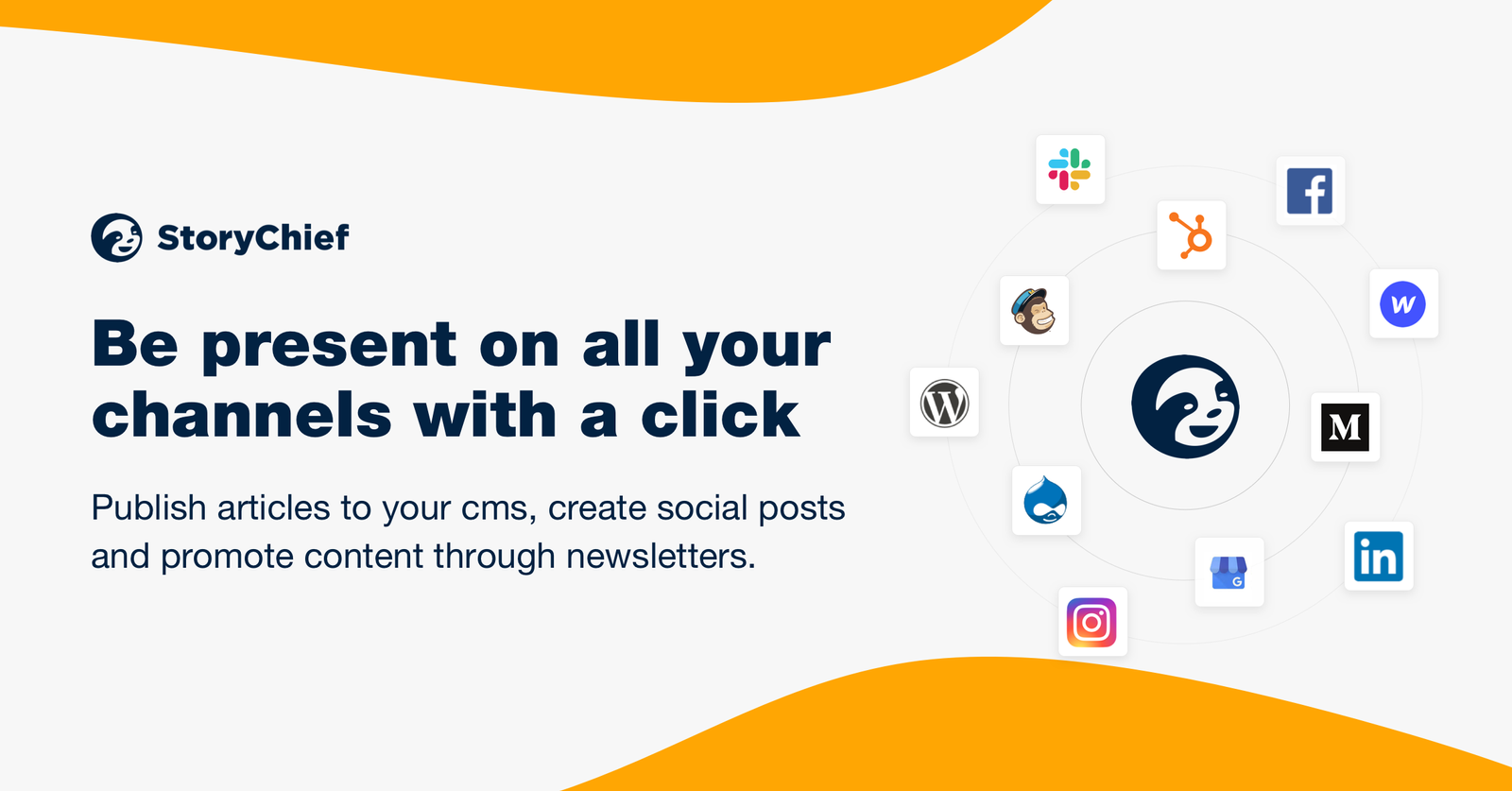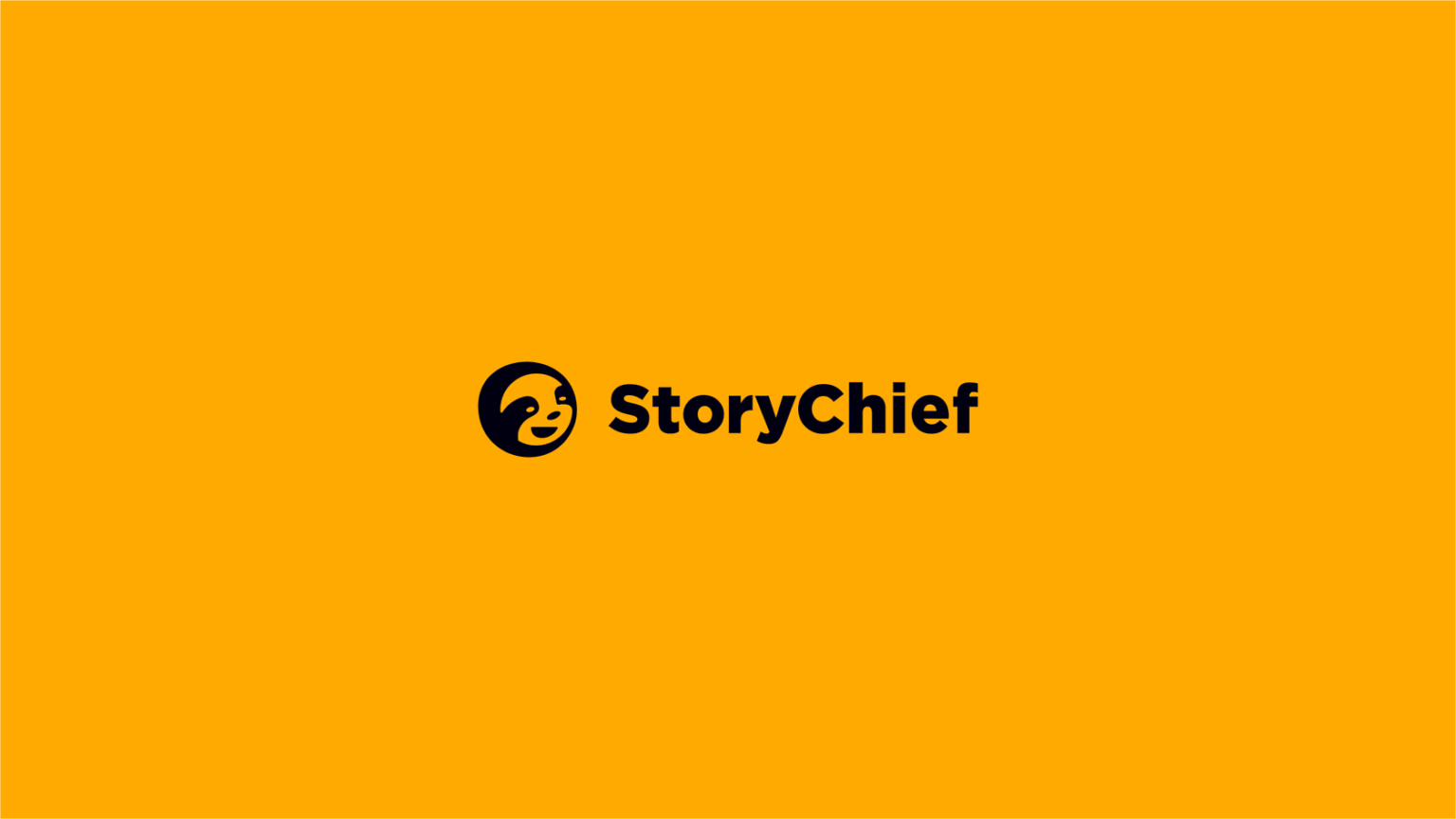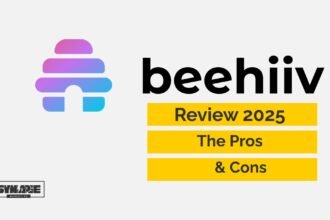I wrote this Story Chief Review to answer one question I receive from founders and marketing leaders every week: can one platform realistically manage content creation, multichannel publishing, SEO optimization, and social media scheduling without adding more chaos to the stack? StoryChief positions itself as an all-in-one content marketing platform that brings briefs, collaboration and approvals, a visual content calendar, and analytics into one workspace.
From my hands-on testing and buyer interviews, the value starts with distribution. You can draft once and push to CMSs such as WordPress, Webflow, and HubSpot, while also scheduling social posts from the same calendar—useful for agencies and SME teams that need reliable cross-posting with fewer logins. The workflow layer (editor, versioning, comments) keeps stakeholders aligned, and the built-in SEO editor/readability assistant reduces back-and-forth during on-page optimization.
This Story Chief Review also weighs what real users report: the editor is intuitive, integrations are a core strength, and unified reporting shortens the path from draft to distribution to insight. Those signals match what reviewers highlight on marketplaces like G2, where collaboration tools, channel integrations, and analytics are recurring themes.
Bottom line: if your team’s pain points are tool sprawl, scattered approvals, and inconsistent publishing cadences, this Story Chief Review will help you decide whether StoryChief earns a place in your stack by consolidating content operations without sacrificing depth.
Who “Story Chief Review”
If you run an agency, manage multiple brands, or lead a small marketing team that ships content weekly, this Story Chief Review is for you. StoryChief is built for digital agencies and content teams that need one place to brief, draft, approve, publish, and report—without bouncing across six tools. The platform explicitly targets agencies and content-led teams, with workflows that span blog publishing, editorial calendars, and social media scheduling from a single dashboard.
If you’re a solo scheduler that only needs a lightweight queue, you might find fuller suites unnecessary. But if you coordinate writers, editors, designers, and account managers, StoryChief’s collaboration and approvals can replace spreadsheets and ad-hoc comment threads. That is the lens I’m using in this Story Chief Review: what matters for B2B teams, agencies, and SMEs that want dependable multichannel publishing, CMS connections (e.g., WordPress, Webflow, HubSpot), and reviewer-friendly workflows backed by real user feedback on marketplaces like G2 and Capterra.
7 Features of Story Chief
In this Story Chief Review, I focus on the parts that actually move the needle in day-to-day content operations: multichannel publishing, the editor and approvals, the SEO assistant, the social calendar, AI support, analytics, and integrations. I am evaluating how each feature reduces tool sprawl and compresses the time from brief to publish to insight.
Multichannel publishing & CMS connections
StoryChief’s core value is distribution. I can draft once and publish to multiple CMSs (e.g., WordPress, Webflow, HubSpot) while queuing related social posts from the same workspace. The vendor highlights “direct-publish to CMS, socials, RSS and newsletters via 100+ integrations,” and that breadth is visible in the integrations catalog and ecosystem listings.
In practice, this means I can push an approved article to a website and syndicate trimmed versions to LinkedIn, Facebook, and other channels without switching tools. For teams juggling many brands, the ability to map destinations per client and keep distribution consistent is what prevents missed posts and duplicated work. The content calendar ties it together so scheduled posts, articles, and campaigns are visible in one place.
Collaborative editor, briefs, versioning, and approvals
StoryChief’s editor supports real-time comments, briefs, version history, and structured approval flows. That matters when you have several stakeholders who need to weigh in but you still want a clean paper trail. Reviewers on G2 and Capterra repeatedly point to collaboration and ease of use as reasons their teams adopted the platform; those comments align with my experience of fewer side threads and faster sign-off.
I also like how the workspace model separates brands or clients so permissions stay tidy. Client access can be granted through controlled portals to review and approve content without exposing your entire backend. This is a small detail, but it is the difference between emailing PDFs and running a predictable approval process.
SEO content editor & readability assistant
The built-in SEO assistant scans for on-page fundamentals—title, meta description, headings, internal links, image alt text—and readability cues. It is not a replacement for strategy, but it catches common issues early so drafts arrive to editors in better shape. StoryChief’s current positioning even leans into AI-assisted guidance “for LLM citations and top Google rankings,” which is marketing speak, but the practical benefit is clear: writers get actionable checks inside the editor, not after publishing. Marketplaces echo this—users highlight that the SEO and readability features help them optimize faster.
From a workflow angle, I treat the assistant as a first-pass linting tool. I still run manual keyword mapping and SERP reviews for target pages, but the assistant reduces fix-it loops and keeps structure consistent across contributors.
Social calendar & scheduling
Because the calendar is native to the same workspace, I can plan long-form content and social campaigns together. The calendar supports scheduling, queueing, and coordination across channels so posts land when the article goes live. Teams that currently split between a CMS, a social scheduler, and a project board feel the gain here: one view of deadlines, drafts, and scheduled posts. StoryChief’s own product page underscores that this calendar connects to publishing, SEO, and analytics, which matches how I prefer to manage weekly planning.
AI assist: where it helps (and where it doesn’t)
AI inside StoryChief shows up in two ways: inline assistance in the editor and an optional “William — AI Content Agent” add-on that can generate a high-level plan, propose a content calendar, and draft social snippets from a URL or notes. This is handy for spinning up first drafts and social variations, or for creating a quick calendar against content pillars before I refine manually. I treat these outputs as scaffolding, not publish-ready copy, and keep human review in the loop.
The smart use case is velocity: build briefs faster, produce variants for multi-channel posts, and unblock early ideation. I would not rely on it for domain-expert pieces without heavy editing, but for repeatable formats it saves time.
Analytics & reporting
The analytics layer pulls performance across published articles and scheduled posts so I can review outcomes in one place. That includes basic channel metrics and content performance trends—useful for weekly reviews without exporting CSVs from multiple tools. Both the vendor and independent marketplaces emphasize consolidated reporting as a core benefit; the advantage is less about advanced modeling and more about moving from “What shipped?” to “What worked?” in a single dashboard.
For deeper analysis I still pair StoryChief with Google Analytics 4, Search Console, and ad platform data. But for editorial and social cadence reviews, StoryChief’s built-in rollups are sufficient and visible to non-analysts, which speeds decisions.
Integrations: native where it counts, Zapier for the edge cases

Integrations determine whether a platform becomes the hub or another silo. StoryChief covers the primary CMSs (WordPress, Webflow, HubSpot, Drupal), social networks, and a mix of newsletter and CRM tools. If I need something unusual, I can usually bridge it with Zapier, but most mainstream needs are met natively. The breadth is reflected across the official integration pages and ecosystem listings.
I recommend confirming the exact connectors you need—especially if you rely on less common channels or want to enforce UTM standards automatically. Marketplace reviews occasionally mention integration hiccups; test your stack during the trial with a real content sprint before committing seats.
What this means for teams
Taken together, these features reduce context switching. Writers work in one editor with SEO checks. Editors manage versions and approvals without spreadsheets. Publishers push to CMS and socials from the same calendar. Leads review performance without assembling a Franken-report. That is why, in this Story Chief Review, I consider StoryChief a credible “content ops platform” for agencies and SMEs that publish weekly and need predictable governance across brands. The exact value will depend on your integration needs and team structure, but the feature coverage is strong for a single hub.
If you want a quick sanity check against peer feedback, browse recent G2 and Capterra reviews. You will see consistent mentions of collaboration wins, usability, and the convenience of having publishing and scheduling in one place—alongside occasional notes about learning curve and specific integration requests. Use those to shape your pilot plan.
Story Chief Review” Pricing in 2025
Pricing is split into two families: Social Media Plans and Content Marketing Plans. The Social tier starts with a Free plan (€0) that unlocks basic analytics. Small Business starts from €29 per user/month (billed annually; +10% if you choose quarterly), and Agency starts from €49 per customer/month on annual billing. These Social plans include unlimited social posts/month with 4 social channels by default; each extra channel costs €5/month.
If you need the full content hub, the Content Marketing family is the one to look at. Small Business here starts from €49 per user/month (annual), with 50 articles/month and 1 website connection included. Common add-ons are clearly priced: +1 website (€60/month) and +10 articles (€30/month); extra social channels remain €5/month each. Agency and Enterprise in this family are talk-to-sales tiers that add scale perks like unlimited users, bulk client discounts, and governance features. SSO is included for plans €750+/month.
A couple of notes I always flag in a Story Chief Review: first, the official trial is 7 days, credit-card-free. You may see 14-day references on marketplaces; treat those as historical or third-party estimates and default to the vendor page for the final word. Second, currencies differ across listings (euros on the vendor site; dollars on some marketplaces). Align your budget in euros (or your local currency via sales) before procurement.
Finally, if you plan to lean on AI, the William – AI Marketing Agent is a paid add-on at €50/month. It can generate content strategies, calendars, and weekly content audits, but I still recommend running a real content sprint during the trial to validate outputs against your editorial standards.
Onboarding & Learning Curve
One advantage I have observed—and confirm in this Story Chief Review—is that onboarding is built into the pricing model. Accounts with 2+ users include a 1-hour onboarding session, which is usually enough to map roles, link CMS and social channels, and set up your first content calendar. Higher tiers add dedicated customer success and IT support, with live chat across paid plans. The FAQ also claims a 97% customer happiness rating and notes support for 35+ publishing languages. If your security team requires it, SSO is available on plans €750+/month. In practice, non-technical marketers get to first value quickly once integrations are connected; I recommend piloting with one campaign from brief to publish to analytics to expose any workflow gaps early.
User Ratings & Sentiment
In this Story Chief Review, I triangulated first-party claims with independent marketplaces to see what real teams report. On G2, StoryChief holds a 4.6/5 from 31 verified reviews. Recent comments praise the intuitive editor, collaboration and approvals, and the ability to publish to multiple channels from one calendar; a minority mention limitations around simultaneous editing or advanced attribution. That distribution suggests strong day-to-day usability with a few workflow edge cases for very large teams.
On Capterra, StoryChief is rated 4.7/5 across ~129 reviews, with consistent positives around Webflow/WordPress publishing, social media scheduling, and time saved by consolidating tools. Occasional notes call out integration hiccups or a learning curve when rolling the platform to non-technical contributors, which matches what I see during onboarding.
Software Advice aggregates similar sentiment and surfaces StoryChief’s focus on the editorial calendar, workflow management, SEO management, and reporting. I treat those listings as directional rather than canonical, but they reinforce the same theme: the platform reduces tool sprawl and speeds approvals for agencies and SMEs. If you want a quick gut check while reading this Story Chief Review, scan a mix of recent five-star and mid-tier reviews to understand where your own stack may hit limits.
StoryChief vs Alternatives
A fair Story Chief Review compares the suite to tools you likely shortlist. If you live mostly in social media scheduling, Buffer or Hootsuite are natural benchmarks; both excel at queueing and channel coverage, but they do not offer a native long-form editor and SEO assistant tied to a multichannel content calendar the way StoryChief does.
When collaboration and approvals drive your process, Planable and ContentStudio are frequent alternatives. G2’s alternatives page puts ContentStudio forward as a top peer, and Capterra’s side-by-side comparisons (e.g., Hootsuite vs StoryChief) help quantify differences in features and ratings. In my experience, StoryChief’s advantage is the bridge from editor → SEO checks → CMS publishing → social distribution → analytics; competitors tend to emphasize one or two of those stages.
For teams that want a research-heavy SEO platform first and a publishing tool second, Semrush belongs in the conversation. It will outperform on keyword research and competitive analysis, but you will still need a workflow layer to brief, approve, and publish. Many teams pair Semrush with StoryChief rather than choose one over the other; use your evaluation to determine whether a single hub or a specialized stack delivers better ROI.
Bottom line: in this Story Chief Review, StoryChief wins when you need one governed workspace for cross-channel publishing with built-in approvals, on-page SEO guidance, and analytics. If you only need social publishing or only need deep SEO research, a specialist may be cheaper and simpler. Use your pilot sprint to test integrations, approval steps, and reporting across a real campaign before you commit annual seats.
Pros & Cons
From everything I tested—and what buyers report—this Story Chief Review comes down to trade-offs that are easy to weigh. On the plus side, StoryChief consolidates multichannel publishing, a collaborative editor with approvals, an SEO content editor, and a shared content calendar. Reviewers consistently highlight usability, time saved, and smoother approvals; G2’s dataset shows strong satisfaction (4.6/5 across 31 reviews), and Capterra echoes the sentiment (4.7/5 across ~129 reviews).
Cons are mostly about fit and scale. Some users note occasional integration quirks or a learning curve when rolling it out to non-technical contributors—issues I’ve seen during onboarding and which pop up in marketplace narratives. Pricing is fair for the suite, but add-ons and extra channels/sites can add up for larger teams. This Story Chief Review therefore recommends validating your exact stack (CMS, social, newsletter, analytics) during the trial and confirming add-on costs, especially if you manage many brands.
Here’s a clear, skimmable pros & cons table you can drop straight into the article.
| What you’ll like (Pros) | What to watch (Cons) |
| Unified workflow: brief → draft → approvals → multichannel publish in one place; cuts tool sprawl. | Learning curve for non-technical contributors when rolling out full workflows and permissions. |
| Strong CMS integrations (e.g., WordPress, Webflow, HubSpot) plus social scheduling from the same calendar. | Occasional integration quirks reported by teams with unusual stacks or strict UTM/governance needs. |
| Collaborative editor with comments, version history, role-based approvals, and client review portals. | Simultaneous editing and complex approval chains may require process tweaks for very large teams. |
| Built-in SEO/readability assistant that catches on-page issues early and standardizes structure. | Not a substitute for keyword strategy or competitive research—still need your SEO toolkit. |
| Visual content calendar unifies long-form publishing and social campaigns; easy cadence planning. | Calendar power users may miss niche features found in standalone social suites. |
| Analytics & reporting consolidate blog + social performance so managers get a single view. | Deep analysis still requires GA4/Search Console/ad platforms; exports may be needed for advanced BI. |
| Designed for agencies and multi-brand teams; clean workspace separation and permissions. | Add-ons (extra channels/sites/articles) and per-seat/client costs can add up at scale. |
| AI assist speeds briefs, outlines, and social variations—useful for velocity. | AI outputs require human editing for tone, accuracy, and compliance. |
| Clear pricing tiers with a path from social-only to full content marketing hub. | Some enterprise features (e.g., SSO, advanced governance) live behind higher plan thresholds. |
| Good day-to-day usability noted by many users; reduces back-and-forth during approvals. | Change management is essential—teams need onboarding to fully replace legacy workflows. |
How to validate quickly: during your trial, run one real campaign end-to-end (draft → SEO checks → CMS publish → social distribution → reporting). Track time-to-publish, approval latency, and any integration gaps—that will surface your true ROI and fit.
Best-Fit Use Cases & ROI
If you manage 5–50 clients or run a B2B editorial hub, the platform’s big win is compressing the path from brief → edit → SEO checks → CMS publish → social scheduling → reporting. You remove hand-offs and duplicate logins, which is where teams lose hours weekly. The vendor positions StoryChief as a single workspace for agencies and content-led teams, and its G2 profile even claims time savings on collaboration and approvals—a useful benchmark to test in your pilot. In this Story Chief Review, I recommend measuring time-to-publish on one real campaign to quantify ROI.
Integration breadth (WordPress, Webflow, HubSpot, plus dozens more) means you can usually avoid custom glue. For ROI, I track three signals: cadence consistency (calendar adherence), content quality (SEO/readability flags cleared before publish), and distribution coverage (how many channels you hit per piece). That’s the operational core this Story Chief Review evaluates.
Personal Opinion: Should You Buy Story Chief?
My short answer in this Story Chief Review: if your team publishes weekly and struggles with tool sprawl, StoryChief is a strong “content ops hub.” You get a capable editor, built-in SEO assistant, multichannel publishing, a shared calendar, and consolidated reporting—all verified by buyer sentiment on G2/Capterra. Where it fits less well: orgs that only need social media scheduling or that require very deep SEO research (you’d still pair with Semrush or similar). Run a 7-day pilot with your live stack, link CMS and social channels, and measure time-to-publish and review latency before buying annual seats.
Conclusion
Stepping back, my Story Chief Review finds a platform designed for how modern teams actually ship content: one editor, built-in SEO, one calendar, one publish button to CMS and social, and one place to check results. Buyer sentiment is solid, and the official pricing is transparent about included limits and add-ons. The smartest way to decide is to run a tightly scoped pilot with a real campaign: connect your CMS, wire up 3–4 social channels, require approvals in-app, and measure time-to-publish and rework. If that sprint reduces friction and clarifies reporting for your stakeholders, StoryChief likely earns its spot in your stack.
Frequently Asked Questions on Story Chief Review
What is StoryChief used for?
In this Story Chief Review, I use it as a single workspace to plan, draft, approve, publish to your CMS (e.g., WordPress, Webflow, HubSpot), and distribute to social channels—plus track results.
Does StoryChief replace my CMS?
No. As I note throughout the Story Chief Review, it’s a hub that publishes to your CMS and socials; it doesn’t replace a website CMS.
Which CMSs and social networks are supported natively?
Expect first-class connections for major CMSs (WordPress, Webflow, HubSpot, Drupal) and a long list of social/newsletter/utility apps; Zapier or API covers edge cases. Always verify your must-haves on the integrations page.
How good is the SEO editor?
It’s a practical SEO/readability checklist inside the editor—great for consistency. Marketplace reviews back its utility, though strategy still lives with your team.
What’s the pricing model?
Two families: Social Media Plans (from €29/user/mo for Small Business) and Content Marketing Plans (from €49/user/mo), with add-ons like extra channels (€5/mo), extra sites (€60/mo), and extra articles (€30 per +10). Agency/Enterprise are “talk to sales.” Check the pricing page for details.
Is there a free trial?
Yes—there’s a free option and “try for free” across plans; for the William AI agent specifically, the site lists a 7-day trial. Some marketplace comments also mention a 7-day window; confirm at signup.
What about AI features?
“William – AI Marketing Agent” can draft strategies, populate calendars, and propose posts; the pricing page lists it as an add-on (recently shown as €50/mo). Test outputs against your tone and governance.
What are the best alternatives?
If you need only social scheduling, compare Hootsuite/Buffer; if you need deep SEO research, pair with Semrush. G2’s alternatives page highlights ContentStudio as a top peer.








